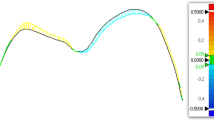Abstract
The study is aimed to evaluate the dimensional accuracy, the effect of undercut of two different configurations and the elastic recovery of addition silicone impression material assessed indirectly, by measuring the dimensions on stone models recorded from the impression of the master model, using one-step and two-step impression technique, for addition silicone impression materials. Measurements are taken to evaluate horizontal or linear and vertical dimensional changes, of the abutment V and abutment C from the stainless steel model. Heavy body/light body material is used for making one-step impression technique in a custom tray. Putty/light body is used for taking two-step technique in a stock metal tray. Improved die stone is used for pouring the impression. The different 11 locations on the dies produced by two different techniques are measured microscopically on image analyzer and compared with those of stainless steel model. Anova test was applied to test the differences of mean values of inter and intra abutment measurements, to calculate p value. Unpaired t test was applied to calculate t value. Results showed less deviation of stone models produced by one-step technique from stainless steel model, whereas the deviation of stone models produced by two-step is comparatively more. (p < 0.01). This difference of deviation is significantly less in one-step as compared to two-step technique. One-step is sufficiently dimensionally accurate than two-step technique in conjunction with addition silicone impression material. They have the best elastic recovery from the two undercut configurations.










Similar content being viewed by others
References
de Araujo PA et al (1985) Effect of material bulk on the accuracy of impression materials. J Prosthet Dent 54(6):791–794
Breedling LC et al (1994) Custom impression trays: part 1-mechanical properties. J Prosthet Dent 71(1):31–34
Chai JY et al (1991) Adhesive properties of several impression material systems: part 2. J Prosthet Dent 66(3):287–292
Ciesco JN et al (1981) Comparison of elastomeric impression materials used in fixed prosthodontics. J Prosthet Dent 45(1):89–94
Eames WB et al (1979) Accuracy and dimensional stability of elastomeric impression materials. J Prosthet Dent 42(2):159–162
Gunther G, Welsh SL (1978) Evaluation of of rubber base impression materials. J Prosthet Dent 39(1):95–99
Hung SH et al (1992) Accuracy of one step verses two step putty wash addition silicone impression technique. J Prosthet Dent 67(5):583–589
Johnson GH, Craig RG (1985) Accuracy of four types of rubber impression materials compared with time of pour and repeat of models. J Prosthet Dent 53(4):484–490
Johnson GH, Craig RG (1986) Accuracy of addition silicones as a function of techniques. J Prosthet Dent 55(2):197–203
Conflict of interest
None.
Author information
Authors and Affiliations
Corresponding author
Rights and permissions
About this article
Cite this article
Pande, N.A., Parkhedkar, R.D. An Evaluation of Dimensional Accuracy of One-Step and Two-Step Impression Technique Using Addition Silicone Impression Material: An In Vitro Study. J Indian Prosthodont Soc 13, 254–259 (2013). https://doi.org/10.1007/s13191-012-0182-1
Received:
Accepted:
Published:
Issue Date:
DOI: https://doi.org/10.1007/s13191-012-0182-1




